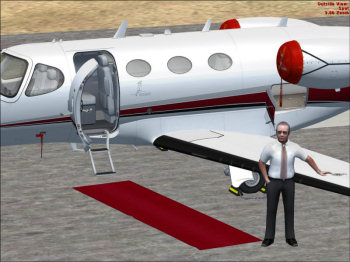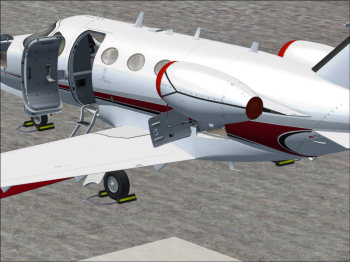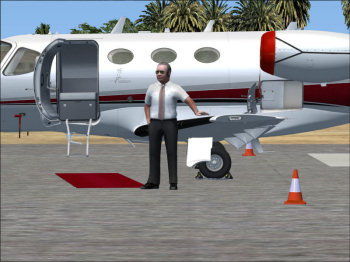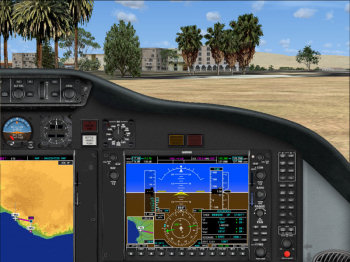
Cessna Citation 510 VLJ (FSX)
Published by Flight1 Software
Review by Martin Wilby
January 2009
Introduction
Back in May, Flight1 Software presented their customers with the F1-Cessna
Mustang Xperience, a web site dedicated to their latest offering, the $2.65m
Citation 510 VLJ.
This updated review, following the release of service pack 2, attempts to
provide the potential purchaser with an insight into the quality of the
product, a run-down of the inevitable and unavoidable bugs that we’ve come
to expect in a new release and a few hints and tips in regard to the
operation of the Mustang. The initial review was begun a mere five days
after release, therefore it was not based on any additional service packs
and so in fairness to the developer, could indeed have been regarded as an
immature product. Therefore it’s very appropriate that the review be updated
in light of the products new features.
A little about the Cessna Mustang
Boasting a top speed of 340 knots the Mustang is perfectly capable of
transporting its lucky passengers 1,300nm in total comfort or maintaining
adequate separation behind a single engine prop on the glideslope at 90
knots. The Mustang’s wing has an all-new design, with a slight leading edge
sweep; consequently the aircraft has an extremely low stall speed, allowing
a typical landing approach of 90 knots, but still with minimal drag to
deliver a 340-knot true airspeed in the cruise. In addition, with a span of
nearly 43 feet and an area of 210 square feet, the Mustang wing is perfectly
happy at the certified ceiling of 41,000 feet.
The first thing that becomes apparent when you step into the cockpit of the
Mustang is the absence of an overhead panel. Cessna realised that purchasers
of the Mustang could well be stepping up from smaller prop aircraft and that
the absence of an overhead panel would make the transition easier. All of
the gauges and switches are mounted on the instrument panel and centre
console and in addition the thrust levers, flap lever, pitch trim wheel and
flight management system alphanumeric keypad. The instrument panel is
dominated by two large primary flight displays and a huge centrally mounted
multi-function display, providing the pilot with information from the very
capable Garmin G1000 integrated avionics suite, delivering comprehensive
at-a-glance awareness.
Two next-generation, FADEC equipped Pratt & Whitney Canada PW615F engines
power the Mustang. These remarkable jet engines deliver 1,460 pounds of
takeoff thrust each, powering the aircraft to a cruise speed that any VLJ
would be proud of.
External Model and Features.
As evident from the accompanying screenshots, the Flight1 Mustang does not
disappoint in regard to external detail and features.
Cabin and cargo storage bay doors open with accompanying CAS messages displayed in the cockpit and in addition the storage bay is illuminated at night, and for those of you that fancy rolling out the red carpet for your prestigious client, that too is possible via the pop-up auxiliary panel. So plenty to entertain the virtual pilot in regard to the exterior although some may prefer the absence of the animated pilots, if so don’t despair, they can be controlled via the auxiliary pop-up panel, a wise choice in my opinion as I for one prefer their absence.
Cockpit Availability and Features
Flight1 have generously provided a plethora of 2D panels, enough to please any flight simulator fan, including six instrument panel
views, (three views for pilot and co-pilot)
pop-up’s for 2D Primary Flight Display, Multi-Function Display, Autopilot, Left and Right Lower Panel, and MFD Controller panel
views. Pop-up instrument panel placards are also available from the 2D panel. 2D panel views can be negotiated via the PC keyboard
or by use of the supplied click-spots. In addition, a removable panel-switcher is available for those that prefer this option. The
pop-up instruments can be resized or moved to any position on the screen.





